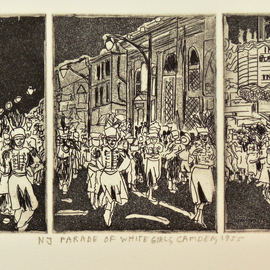Masonic Christmas Portal Printmaking By Jerry Di Falco
Artwork For Sale ❯ Printmaking ❯ Jerry Di Falco ❯ Architecture ❯ Masonic Christmas Portal
Artist:
Jerry Di Falco
Title:
Masonic Christmas Portal
Price:
Year:
2019
Medium:
Size - (USA):
20 W x 16 H x 1 D (inches)
Size - (metric):
50.8 W x 40.6 H x 2.5 D (centimeters)
Theme:
Edition:
Original
Artwork ID:
631512
PDF Copy:
Artwork Description:
The image in this hand printed etching by Di Falco, which was adapted from his 1998 photos taken during a tour of the Philadelphia Masonic Temple, represents one of the city’s most accomplished architectural wonders. The etching, executed on a zinc plate, has only FOUR EDITIONS, and each edition is limited to only five original prints. Di Falco used a layer of liquid ground on the zinc, which consisted of melted beeswax, mineral spirits, and oil of spike lavender. Once the ground dried overnight, the artist transferred his combined drawings onto the treated etching plate, but in reverse. This is because when the plate goes through the press, its image prints from right to left. DiFalco next drew into the ground with etching needles and then placed the plate in a bath of Nitric acid for development. Note: The acid eats into any etched lines. Constant surveillance during this step is required, and the plate is brushed gently with a goose feather to remove bubbles that may settle over the lines. The studio techniques of aquatint, drypoint, Chine collè, and intaglio were employed to create this etching. This particular original print is Number 1 of 5 in the LAST of FOUR. Each edition is executed in different ink-color and paper combinations. The image measures ten inches wide by eight inches high, or 25.400cm by 20.320cm and, the print is fifteen inches wide by twelve inches high, or 38.100cm by 30.480cm. The frame measures 16 inches high by 20 inches wide, and this final edition was printed on RivesBFK white paper from France with a created blend of French inks from both Paris and London. The work includes an archival mat and a wood with glass frame. Style of frame is semi-ornate and the color of paint is gold. The building pictured in this etching is situated at One North Broad Street, just north of Philadelphia City Hall it was constructed in 1873. The architect--James Hamilton Windrim, 1840-1919--incorporated seven lodge halls within the massive structure to reflect the seven “ideal” architectural styles: Renaissance, Ionic, Oriental, Corinthian, Gothic, Egyptian, and Norman. The Philadelphia Masonic Temple is one of the best examples of post-Civil War architecture in the United States. The price of this work, which contains over one thousand etched lines, includes all packing materials, professional shipment carton, Certificate of Authenticity, a matt, a frame, and the original etching. The work was hand printed by the artist at The Center for Works on Paper, located at 705 Christian Street, in Philadelphia, Pennsylvania. The Fleisher art school is located on the 700 block of Catharine Street and is associated with The Philadelphia Museum of Art. NOTE: In the Chine collè process, which translates from French into English as Chinese Pasting, DiFalco treats hand dyed mulberry bark paper from Thailand with methylcellulose. This specific brand is Unryu, which is infused with Japanese kozo, mulberry bark, threads. Once dry, DiFalco manually cuts seven tiny shapes from the mulberry bark paper and applies them directly to the inked and wiped zinc plate before running it through the press. These cut mulberry bark shapes are then individually dampened with tiny brushes using spring water to reconstitute the glued side--the side covered with dried methylcellulose. In this case, the process gives the six windows on the main door and semi-circular window above it with yellow and red areas. In addition, the special inking and plate wiping techniques endow the etching with a haunting, secretive aura.
Artwork Keywords:
Masonic Temple, Philadelphia, Arches, Geometry, Lodge, , Original Printmaking
























